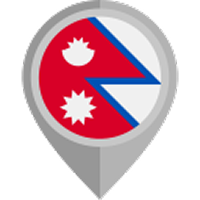Nepal vision | 26/09/2024
Climbing admirers often find themselves stuck choosing their next destination of the appealing and majestic peak. In such a situation, Mera Peak and Kilimanjaro are among the famous choices.
Mera Peak, about 6476 m, lies in the heart of the Nepalese Himalayas. It is one of the highest trekking peaks in Nepal and offers a fantastic chance to be part of the Everest trekking trail.
Mt Kilimanjaro, located in Tanzania in Africa, is the highest trekking peak at 5895m. Both peaks offer different landscapes and opportunities.
While the experience is magical, many climbers wonder if Mera Peak is harder than Kilimanjaro. Despite its height, Mera Peak has few technical difficulties compared to the other trekking peaks. However, some factors contribute to the difficulty. Let us clarify everything about Mera Peak and its difficulty compared to Kilimanjaro.
Overview of Mera Peak

Mera Peak is located in the Solukhumbu region of Nepal. It has three main summits: Mera North, Mera South, and Mera Central. The Nepal Mountaineering Association has classified it as a class A trekking peak.
The route to Mera Peak starts from the little mountain Hamlet called Lukla, the gateway to Everest. As you follow the trek through the scenic villages of Paiya, Pangonma, and the Sherpa culture, the places you visit are truly unique.
Besides, you walk around 10 days with proper acclimatization and finally reach Khare. From here you begin your journey to the peak climbing to Mera Base Camp and to the high camp.
While there is no technical difficulty, the altitude can be a challenge at this peak. Despite this, the rewards it offers are truly magical.
- From the beginning of your trail, you are cheered on by the majestic smiles of Everest, Lhotse, Makalu, Kanchenjunga, Cho Oyu, Nuptse, Ama Dablam, Kusum Kangaru, and many more.
- Apart from the flying chorten, the encrypted Mani wall, the spring praying wheel and the monastery along the way will give you a deep perspective of friendly Sherpa people and their culture.
- Walking through the Makalu Barun National Park, you will encounter a diverse range of plants: 25 species of rhododendrons, 47 types of orchids, and 56 rare plants. At the same time, endangered species of animals like Snow leopard, red panda, musk deer, and wild boar are found there.
Overview of Kilimanjaro

Mt Kilimanjaro is on the border of Kenya and Tanzania and stands at 5895m. Many know it as the tallest freestanding mountain in the world.
But the fun fact is it is also the home to the dormant composite volcano formed from Kibo, Mawenzi, and Shira. The landscape of the mountain as you trek, you cross tropical forests and alpine desert.
The routes like the Lemosho route and the Marangu route are among the famous ones. Although, there is another route, too.
Each of them gives you a diverse chance to immerse in the beautiful scenery. Besides, Kilimanjaro is 205 miles from the equator, which allows them to adorn all the diverse landscapes in them.
After walking for 7-8 days, you will reach the peak of the Kilimanjaro. While climbing is nontechnical, it requires good physical fitness. Do not worry, as your hard work is rewarded by several things.
- In addition to the diverse landscape, you will meet the local Chaga people and learn about their culture and lifestyle in the mountain region.
- Since the tropical forest is part of the trail, you will undoubtedly meet endemic species like elephants, colobus monkeys, and giant lobelias.
- The highest point of Kilimanjaro's Kibo cone offers breathtaking views of the Maasai Steppe, Mt Meru, Mt Longido, and the 'Mountain of God', Ol Doinyo Lenga.
- You will see different vegetation zones each day that make this trekking peak stand out in the region.
Mera Peak Vs Kilimanjaro
Now, let us come to the question you all have been looking for as we discuss the detailed comparison between Kilimanjaro and Mera Peak.
Altitude comparison
Mera Peak stands at 6476m, which is higher than Kilimanjaro's 5895m. The higher elevation is a challenge for the climber as it increases the chances of altitude sickness. To prevent this, plenty of rest, hydration, and acclimatization are required.
Technical Difficulty
Climbing Mera Peak requires basic mountaineering skills and crampons. Navigating glaciers increases the technical difficulty. In contrast, climbing Kilimanjaro is non-technical and requires no climbing equipment.
Physical Endurance
On Mera Peak's trail, you can expect to take 15 days to complete the journey. Besides, you have to walk around 6-7 hours a day. It is because you get to immerse yourself in the beauty of the Everest region that it also becomes a once-in-a-lifetime opportunity. Meanwhile, the route to Kilimanjaro takes about 6-10 days.
Final Verdict
Well, the fact that Mera Peak is at a higher elevation than Kilimanjaro makes it harder. Despite that, the trail of the Mera Peak is classified as a trekking peak because of its low difficulty. There are only two mountains in Nepal above 6000m in height that have less technical difficulty and are classified as trekking peaks, and Mera Peak is one of them.
The success rate of Mera Peak is 95%, which is more than that of any other trekking peak or mountain. Despite this, Kilimanjaro and Mera both have different challenges and have amazing experiences. The choice between these two depends on you.
But when you prepare for your journey, you must get information from a field expert. Feel free to reach out to us at Nepal Vision Trek for expert guidance and help.
FAQ









